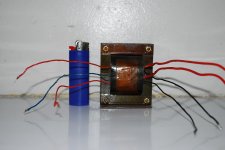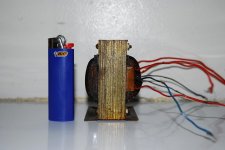Gday Guy's,
I found an old OPT & did some calculations to work out the Impedance.
I worked this out using a frequency of 500Hz about mid range for the Guitar signal.
Primary side first:
L = 14.9H, DC resistance is 805 Ohms
XL = 2pi f L
= 6.28 X 500 X 14.9
= 46,786 Ohms
ZL = sqrt R^2 + XL^2
= 14,797 Ohms
Secondry side:
L = 3mH DC Resistance is .6 Ohms
XL = 2pi f L
= 6.28 X 500 X .003
= 9.42 Ohms
ZL = sqrt R^2 + XL^2
= 9.4 Ohms
My question is that of course that ZL changes with frequency so at what frequency should we work out these figures.
By choosing the approx mid range of the guitar frequencies 500Hz, did I in fact do the correct thing.
The thing that bothers me is that some of the harmonics --- overtone frequencies from guitars are a lot higher than the fundamental string frequencies.
What bearing has the output transformers of tube amps actually have on these overtone frequencies.
It would seem it could actually make or break a truly great guitar & or Guitar amplifier?
Cheers
I found an old OPT & did some calculations to work out the Impedance.
I worked this out using a frequency of 500Hz about mid range for the Guitar signal.
Primary side first:
L = 14.9H, DC resistance is 805 Ohms
XL = 2pi f L
= 6.28 X 500 X 14.9
= 46,786 Ohms
ZL = sqrt R^2 + XL^2
= 14,797 Ohms
Secondry side:
L = 3mH DC Resistance is .6 Ohms
XL = 2pi f L
= 6.28 X 500 X .003
= 9.42 Ohms
ZL = sqrt R^2 + XL^2
= 9.4 Ohms
My question is that of course that ZL changes with frequency so at what frequency should we work out these figures.
By choosing the approx mid range of the guitar frequencies 500Hz, did I in fact do the correct thing.
The thing that bothers me is that some of the harmonics --- overtone frequencies from guitars are a lot higher than the fundamental string frequencies.
What bearing has the output transformers of tube amps actually have on these overtone frequencies.
It would seem it could actually make or break a truly great guitar & or Guitar amplifier?
Cheers
A transformer does not really have an impedance, it transforms impedance. However, it will work best at and around the impedances intended by the designer.
The impedance ratio is roughly equal to the inductance ratio, so yours is 14.9H/3mH = 5000:1 so this will transform 3R to 15K, or 8R to 40K. Assume it was intended for the former, although even this has quite a high primary impedance. Then calculate the LF limit as the point where the matching impedance is equal to the inductive reactance: 15K = 14.9 x 2pi x f, so f = 160Hz. The HF limit depends on stray capacitance so needs to be measured, not calculated.
My guess is that this OPT came from a cheap radio or very low power practice amp. The low primary inductance and high primary resistance indicates this. My guess is that it would only work up to 1-2 watts output.
The impedance ratio is roughly equal to the inductance ratio, so yours is 14.9H/3mH = 5000:1 so this will transform 3R to 15K, or 8R to 40K. Assume it was intended for the former, although even this has quite a high primary impedance. Then calculate the LF limit as the point where the matching impedance is equal to the inductive reactance: 15K = 14.9 x 2pi x f, so f = 160Hz. The HF limit depends on stray capacitance so needs to be measured, not calculated.
My guess is that this OPT came from a cheap radio or very low power practice amp. The low primary inductance and high primary resistance indicates this. My guess is that it would only work up to 1-2 watts output.
DF96,
Thanks for the reply, yes I see what you mean with the LF limit.
I am not sure what the transformer was used for, it has E & I laminations with the centre leg core about 25mm square.
I will do a couple of tests & see what I can get out of it, it has two seconary windings, one of them is about 1mm in diameter.
I will attach a picture of it with a cigarette lighter next to it for a size comparison.
Thanks again
Cheers.
Thanks for the reply, yes I see what you mean with the LF limit.
I am not sure what the transformer was used for, it has E & I laminations with the centre leg core about 25mm square.
I will do a couple of tests & see what I can get out of it, it has two seconary windings, one of them is about 1mm in diameter.
I will attach a picture of it with a cigarette lighter next to it for a size comparison.
Thanks again
Cheers.
Attachments
You should be able to get the turns ratio by applying a low-amplitude signal to the secondary and measuring the primary voltage. The turns ratio is then found as N = Vsecondary/Vprimary. The primary impedance for a given secondary load impedance will be Zprimary = Zload/(N^2).
Be careful during the measurement as the primary voltage can be quite high.
~Tom
Be careful during the measurement as the primary voltage can be quite high.
~Tom
DF96,
Thanks for the reply, yes I see what you mean with the LF limit.
I am not sure what the transformer was used for, it has E & I laminations with the centre leg core about 25mm square.
I will do a couple of tests & see what I can get out of it, it has two seconary windings, one of them is about 1mm in diameter.
I will attach a picture of it with a cigarette lighter next to it for a size comparison.
Thanks again
Cheers.
The above estimate was about right. Just from the photo I can see this would but be the best for even a 5W amp. But so called "flea powered" guatar amps can sound good and make a good practice amp for bedroom level volume.
A better way to measure the transformers is to find the turns ration. Just put an AC voltage on one side and look at the volts on the other side. the Impedance ratio is the square of the voltage ratio.
I think maybe you could build and amp using 12AU7 tube as the "power" tube and get about one to two watts output. Impedance seems about right for a 12AU7
Last edited:
Thanks for the replies everyone,
I see now how your working things out, it's all a learning curve for me at the moment but I am getting there slowly.
Like i've mentioned before I am a Luthier & want to try a few things out for my guitars in the way of some tube amps.
ChrisA,
HaHa, yes I know what your saying with the Flea powered amps, a customer of mine has a small 12AU7 amp that he uses at home & he really gets some nice tones out of it while it bounces around the floor, it's very surprising. If he could size it up it would be a fantastic amp.
Thanks again everyone.
Cheers
I see now how your working things out, it's all a learning curve for me at the moment but I am getting there slowly.
Like i've mentioned before I am a Luthier & want to try a few things out for my guitars in the way of some tube amps.
ChrisA,
HaHa, yes I know what your saying with the Flea powered amps, a customer of mine has a small 12AU7 amp that he uses at home & he really gets some nice tones out of it while it bounces around the floor, it's very surprising. If he could size it up it would be a fantastic amp.
Thanks again everyone.
Cheers
- Status
- This old topic is closed. If you want to reopen this topic, contact a moderator using the "Report Post" button.
- Home
- Amplifiers
- Tubes / Valves
- OPT Impedance

